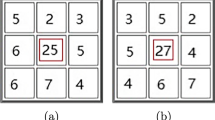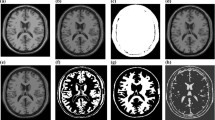Abstract
In modern imaging diagnosis Magnetic Resonance Imaging (MRI) is possibly one of the widely used effective techniques particularly for brain tissue segmentation. Clustering techniques may not be perfect always. Clustering can be significantly improved by supervising partially. A novel partially supervised kernel induced rough fuzzy clustering is proposed for brain tissue segmentation by employing a small quantity of labeled pixels with constraint seeded policy. Labeled pixels act as the constraints which are utilized to initialize the clustering process and guide the method towards a more accurate partitioning. Kernel trick used here enhances the possibility of linear partition of different complex segments of brain which cannot separate linearly in its original feature space. Whereas, the rough and fuzzy set handles the overlappingness, vagueness and indiscernibility of different tissue regions. A variety of benchmark brain MRI datasets are used for the experiments. The ability of the method is compared with state-of-the-art clustering segmentation techniques and evaluated using different validity indices. Experimental results confirm that the technique considerably enhances the segmentation accuracy with a little quantity of supervision. Enhancement in accuracy gained by the method compared to the other techniques are 0.3, 0.37, 1.15, and 1.03% for IBSR datasets 144, 150, 155, and 167, respectively, and 1.02% for the BrainWeb dataset 85. Statistical impact of the method is confirmed from the paired t-test results.









Similar content being viewed by others
REFERENCES
M. C. Wittrock, The Brain and Psychology (Academic Press, 1980).
T. W. Vanderah and D. J. Gould, Nolte’s The Human Brain: An Introduction to Its Functional Anatomy, 7th ed. (Elsevier, 2015).
Mayfield Education and Research Foundation. Anatomy of the Brain. http://www.mayfieldclinic.com/pe-anatbrain.htm. Accessed March 24, 2020.
L. M. Biga, S. Dawson, A. Harwell, R. Hopkins, J. Kaufmann, M. Le Master, P. Matern, D. Quick, K. M. Graham, and J. Runyeon, Anatomy and Physiology. https://openstax.org/details/books/anatomy-and-physiology. Accessed March 24, 2020.
P. Suetens, Fundamentals of Medical Imaging (Cambridge Univ. Press, Cambridge, UK, 2002).
M. A. Haidekker, Medical Imaging Technology (Springer, New York, 2013).
S. Bauer, R. Wiest, L. P. Nolte, and M. Reyes, “A survey of MRI based medical image analysis for brain tumor studies,” Phys. Med. Biol. 58 (13), 97–129 (2013).
P. Maji and S. K. Pal, Rough-Fuzzy Pattern Recognition: Applications in Bioinformatics and Medical Imaging (John Wiley & Sons, Inc., New Jersey and Canada, 2012).
D. L. Bailey, D. W. Townsend, P. E. Valk, and M. N. Maisey, Positron-Emission Tomography: Basic Sciences (Springer-Verlag, Secaucus, 2005).
A. M. Cormack and G. N. Hounsfield, The Nobel Prize in Physiology or Medicine for the Development of Computer-Assisted Tomography. https://www.nobelprize.org/1979. Accessed March 24, 2020.
Single-Photon Emission-Computed Tomography. http://id.nlm.nih.gov/mesh/D015899. Accessed March 24, 2020.
R. J. English, SPECT: A Primer, 3rd ed. (Soc. Nucl. Med., CNMT, Reston, 2005).
N. P. Alazraki, M. J. Shumate, and D. A. Kooby, A Clinicians Guide to Nuclear Oncology (Soc. Nucl. Med. Mol. Imaging, Reston, 2007).
National Research Council (US) and the Institute of Medicine (US) Committee, Mathematics and Physics of Emerging Dynamic Biomedical Imaging (Natl. Acad. Press, Washington D.C., 1996).
M. A. Balafar, A. R. Ramli, M. I. Saripan, and S. Mashohor, “Review of brain MRI image segmentation methods,” Artif. Intell. Rev. 33 (4), 261–274 (2010).
C. M. Bishop, Pattern Recognition and Machine Learning (Information Science and Statistics) (Springer Verlag, New York, 2006).
R. C. Gonzalez and R. E. Woods, Digital Image Processing, 3rd ed. (Pearson Prentice Hall, 2007).
S. Theodoridis and K. Koutroumbas, Pattern Recognition, 4th ed. (Academic Press, New York, 2009).
H. R. Singleton and G. M. Pohost, “Automatic cardiac MR image segmentation using edge detection by tissue classification in pixel neighborhoods,” Magn. Reson. Med. 37 (3), 418–424 (1997).
I. N. Manousakes, P. E. Undrill, and G. G. Cameron, “Split and merge segmentation of magnetic resonance medical images: Performance evaluation and extension to three dimensions,” Comput. Biomed. Res. 31 (6), 393–412 (1998).
B. N. Subudhi, V. Thangaraj, E. Sankaralingam, and A. Ghosh, “Tumor or abnormality identification from magnetic resonance images using statistical region fusion based segmentation,” Magn. Reson. Imaging 34 (9), 1292–1304 (2016).
S. Banerjee, S. Mitra, and B. Umashankar, “Single seed delineation of brain tumor using multi-thresholding,” Inf. Sci. 330 (4), 88–103 (2016).
J. C. Rajapakse, J. N. Giedd, and J. L. Rapoport, “Statistical approach to segmentation of single channel cerebral MR images,” IEEE Trans. Med. Imaging 16 (2), 176–186 (1997).
A. Banerjee and P. Maji, “Rough-probabilistic clustering and hidden Markov random field model for segmentation of HEp-2 cell and brain MR images,” Appl. Soft Comput. 46, 558–576 (2016).
S. Saha and S. Bandyopadhyay, “MRI brain image segmentation by fuzzy symmetry based genetic clustering technique,” in Proceedings of the IEEE Congress on Evolutionary Computation (CEC) (2007), pp. 4417–4424.
P. Maji and S. Roy, “Rough-fuzzy clustering and unsupervised feature selection for wavelet based MR image segmentation,” PLOS ONE 10 (4), 1–30 (2015).
G. Vishnuvarthanana, M. P. Rajasekaran, P. Subbaraj, and A. Vishnuvarthanan, “An unsupervised learning method with a clustering approach for tumor identification and tissue segmentation in magnetic resonance brain images,” Appl. Soft Comput. 38, 190–212 (2016).
J. P. Sarkara, I. Saha, and U. Maulik, “Rough possibilistic type-2 fuzzy c-means clustering for MR brain image segmentation,” Appl. Soft Comput. 46, 527–536 (2016).
S. Ravishankar and Y. Bresler, “MR image reconstruction from highly under sampledk-space data by dictionary learning,” IEEE Trans. Med. Imaging 30 (5), 1028–1041 (2011).
E. S. A. E. Dahshan, H. M. Mohsen, K. Revett, and A. B. M. Salem, “Computer-aided diagnosis of human brain tumor through MRI: A survey and a new algorithm,” Expert Syst. Appl. 41 (11), 5526–5545 (2014).
J. Liu, M. Li, J. Wang, F. Wu, T. Liu, and Y. Pan, “A survey of MRI based brain tumor segmentation methods,” Tsinghua Sci. Technol. 19 (6), 578–595 (2014).
N. Gordillo, E. Montseny, and P. Sobrevilla, “State of the art survey on MRI brain tumor segmentation,” Magn. Reson. Imaging 31 (8), 1426–1438 (2013).
N. Grira, M. Crucianu, and N. Boujemaa, Unsupervised and Semi-Supervised Clustering: A Brief Survey. Technical Report B.P. 105 (INRIA Rocquencourt, 2005).
X. Zhu, Semi-Supervised Learning Literature Survey. Technical Report Computer Sciences TR 1530 (Univ. Wisconsin-Madison, 2008).
S. Basu, A. Banerjee, and R. J. Mooney, “Semi-supervised clustering by seeding,” in Proceedings of the 19th International Conference on Machine Learning (2002), pp. 19–26.
S. Basu, A. Banerjee, and R. J. Mooney, “Active semi-supervision for pairwise constrained clustering,” in Proceedings of the SIAM International Conference on Data Mining (2004), pp. 333–344.
L. H. Son and T. M. Tuan, “Dental segmentation from X-ray images using semi-supervised fuzzy clustering with spatial constraints,” Eng. Appl. Artif. Intell. 59, 186–195 (2017).
S. Saha, A. K. Alok, and A. Ekbal, “Brain image segmentation using semi-supervised clustering,” Expert Syst. Appl. 52, 50–63 (2016).
A. Halder and N. A. Talukdar, “Brain tissue segmentation using improved kernelized rough-fuzzy c-means with spatio-contextual information from MRI,” Magn. Reson. Imaging 62, 129–151 (2019).
B. Scholkopf and A. J. Smol, Learning with Kernels (MIT Press, Cambridge, 2002).
J. S. Taylor and N. Cristianini, Kernel Method for Pattern Analysis (Cambridge Univ. Press, 2004).
L. A. Zadeh, “Fuzzy sets,” Inf. Control 8 (3), 338–353 (1965).
Z. Pawlak, “Rough sets,” Int. J. Comput. Inf. Sci. 11 (5), 341–356 (1982).
Z. Pawlak, Rough Sets: Theoretical Aspects of Reasoning about Data (Kluwer, Dordrecht, 1991).
J. C. Bezdek, R. Ehrlich, and W. Full, “FCM: The fuzzy c-means clustering algorithm,” Comput. Geosci. 10 (2–3), 191–203 (1984).
L. O. Hall, A. M. Bensaid, L. P. Clarke, R. P. Velthuizen, M. S. Silbiger, and J. C. Bezdek, “A comparison of neural network and fuzzy clustering techniques in segmenting magnetic resonance images of the brain,” IEEE Trans. Neural Networks 3 (5), 672–682 (1993).
T. Hofmann, B. Schölkopf, and A. J. Smola, “Kernel methods in machine learning,” Ann. Stat. 36 (3), 1171–1220 (2008).
D. L. Collins, A. P. Zijdenbos, V. Kollokian, J. G. Sled, N. J. Kabani, C. J. Holmes, and A. C. Evans, “Design and construction of a realistic digital brain phantom,” IEEE Trans. Med. Imaging 17 (3), 463–468 (1998).
T. Rohlfing, “Image similarity and tissue overlaps as surrogates for image registration accuracy: Widely used but unreliable,” IEEE Trans. Med. Imaging 31 (2), 153–163 (2012).
C. L. Li, D. B. Goldgof, and L. O. Hall, “Knowledge-based classification and tissue labeling of MR images of human brain,” IEEE Trans. Med. Imaging 12 (4), 740–750 (1993).
P. Maji and S. K. Pal, “RFCM: A hybrid clustering algorithm using rough and fuzzy sets,” Fundam. Inf. 80 (4), 475–496 (2007).
A. Halder, “Kernel based rough fuzzy c-means clustering optimized using particle swarm optimization,” in Proceedings of the International Symposium on Advanced Computing and Communication (ISACC) (2015), pp. 41–48.
S. Chen and D. Zhang, “Robust image segmentation using FCM with spatial constraints based on new kernel-induced distance measure,” IEEE Trans. Syst. Man Cybern. Part B: Cybern. 34 (4), 193–199 (2004).
A. Halder and N. A. Talukdar, “Robust brain magnetic resonance image segmentation using modified rough-fuzzy c-means with spatial constraints,” Appl. Soft Comput. 85, 105758 (2019).
S. Das and S. Sil, “Kernel-induced fuzzy clustering of image pixels with an improved differential evolution algorithm,” Inf. Sci. 180 (8), 1237–1256 (2010).
J. A. Rice, Mathematical Statistics and Data Analysis (Cengage Learning, 2006).
Funding
There was no any funding to carry out the research.
Author information
Authors and Affiliations
Corresponding authors
Ethics declarations
Conflict of interest declared none.
Additional information

Nur Alom Talukdar received the B.Tech. in Computer Science and Engineering and M.Tech. in Information Technology from Gauhati University, Guwahati, and Assam University, Silchar, India, in 2013 and 2015, respectively. He is currently working towards PhD as a Research Scholar in the Dept. of Computer Applications, School of Technology, North-Eastern Hill University, Meghalaya. He has published a number of research articles in internationally reputed journals and refereed conferences. His research interests include, machine learning, pattern recognition, soft computing, and medical image analysis.

Dr. Anindya Halder is presently working as Teacher-in-Charge (HOD) and Assistant Professor in Department of Computer Application, School of Technology, North-Eastern Hill University, Meghalaya, India. He received the Master of Computer Application (MCA) from University of Kalyani, India, in 2005 and PhD in Engineering from Jadavpur University, Kolkata, India, in 2013. He worked (towards Ph.D.) as a Research Scholar at the Center of Soft Computing Research, Indian Statistical Institute (ISI), Kolkata, India during August 2007 to July 2012. Dr. Halder was a Visiting Scientist at Remote Sensing Laboratory, University of Trento, Italy during January 2010–June 2010. He has published a number of research articles in internationally reputed journals and refereed conferences. His research interests include, machine learning, pattern recognition, swarm intelligence, soft computing, remote sensing image analysis, bioinformatics, and medical image analysis.
Rights and permissions
About this article
Cite this article
Nur Alom Talukdar, Anindya Halder Partially Supervised Kernel Induced Rough Fuzzy Clustering for Brain Tissue Segmentation. Pattern Recognit. Image Anal. 31, 91–102 (2021). https://doi.org/10.1134/S1054661821010156
Received:
Revised:
Accepted:
Published:
Issue Date:
DOI: https://doi.org/10.1134/S1054661821010156




